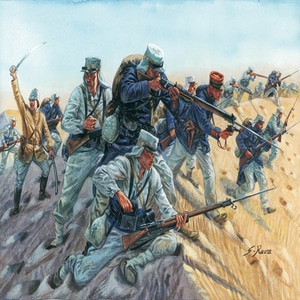
The French Foreign Legion
CBUB Wins: 1
CBUB Losses: 0
CBUB Ties: 0
Win Percentage: 100.00%
Added by: ViceCityMobster86
Read more about The French Foreign Legion at: Wikipedia
Official Site: Public Domain
The Foreign Legion (FFL; , , L.É.) is a military service branch of the French Army established in 1831. Legionnaires are highly trained infantry soldiers and the Legion is unique in that it is open to foreign recruits willing to serve in the French Armed Forces. When it was founded, the Foreign Legion was not unique; other foreign formation existed at the time in France. The Foreign Legion is today known as a unit whose training focuses on traditional military skills and on its strong esprit de corps, as its men come from different countries with different cultures. Consequently, training is often described as not only physically challenging, but also very stressful psychologically. French citizenship may be applied for after three years' service. Any soldier who gets wounded during a battle for France can immediately apply to be a French citizen under a provision known as " " ("French by spilled blood"). As of 2018, members come from 140 different countries.
Since 1831, the Legion has consisted of hundreds of thousands in active service at its peak, and suffered the aggregated loss of nearly 40,000 men in France, Algeria, Morocco, Tunisia, Madagascar, West Africa, Mexico, Italy, Crimea, Spain, Indo-China, Norway, Syria, Chad, Zaïre, Lebanon, Central Africa, Gabon, Kuwait, Rwanda, Djibouti, former Yugoslavia, Somalia, the Republic of Congo, Ivory Coast, Afghanistan, Mali, as well as others. The French Foreign Legion was primarily used to help protect and expand the French colonial empire during the 19th century. The Foreign Legion was initially stationed only in Algeria, where it took part in the pacification and development of the colony. Subsequently, the Foreign Legion was deployed in a number of conflicts, including the First Carlist War in 1835, the Crimean War in 1854, the Second Italian War of Independence in 1859, the French intervention in Mexico in 1863, the Franco-Prussian War in 1870, the Tonkin Campaign and Sino-French War in 1883, supporting growth of the French colonial empire in Sub-Saharan Africa, the Second Franco-Dahomean War in 1892, the Second Madagascar expedition in 1895 and the Mandingo Wars in 1894. In World War I, the Foreign Legion fought in many critical battles on the Western Front. It played a smaller role in World War II than in World War I, though having a part in the Norwegian, Syrian and North African campaigns. During the First Indochina War (1946–1954), the Foreign Legion saw its numbers swell. The Legion lost a large number of men in the catastrophic Battle of Dien Bien Phu against forces of the Viet Minh.
Subsequent military campaigns included those during the Suez Crisis, the Battle of Algiers and various offensives in Algeria launched by General Maurice Challe including Operation Oranie and Operation Jumelles. During the Algerian War of Independence (1954–1962), the Foreign Legion came close to being disbanded after some officers, men, and the highly decorated 1st Foreign Parachute Regiment (1 er REP) took part in the Generals' putsch. In the 1960s and 1970s, Legion regiments had additional roles in sending units as a rapid deployment force to preserve French interests – in its former African colonies and in other nations as well; it also returned to its roots of being a unit always ready to be sent to conflict zones around the world. Some notable operations include: the Chadian–Libyan conflict in 1969–1972 (the first time that the Legion was sent in operations after the Algerian War), 1978–1979, and 1983–1987; Kolwezi in what is now the Democratic Republic of the Congo in May 1978. In 1981, the 1st Foreign Regiment and Foreign Legion regiments took part in the Multinational Force in Lebanon. In 1990, Foreign Legion regiments were sent to the Persian Gulf and participated in Opération Daguet, part of Division Daguet. Following the Gulf War in the 1990s, the Foreign Legion helped with the evacuation of French citizens and foreigners in Rwanda, Gabon and Zaire. The Foreign Legion was also deployed in Cambodia, Somalia, Sarajevo, Bosnia and Herzegovina. In the mid- to late 1990s, the Foreign Legion was deployed in the Central African Republic, Congo-Brazzaville and in Kosovo. The French Foreign Legion also took part in operations in Rwanda in 1990–1994; and the Ivory Coast in 2002 to the present. In the 2000s, the Foreign Legion was deployed in Operation Enduring Freedom in Afghanistan, Operation Licorne in Ivory Coast, the EUFOR Tchad/RCA in Chad, and Operation Serval in the Northern Mali conflict. Other countries have tried to emulate the French Foreign Legion model.
The French Foreign Legion was created by Louis Philippe, the King of France, on 10 March 1831
CBUB Match Record:
| Result | Opponent | My Score | Their Score | |
|---|---|---|---|---|
| Win | Minute Men (Kaiserreich) | 2 | to | 1 |
No Fantasy Draft Records Available
